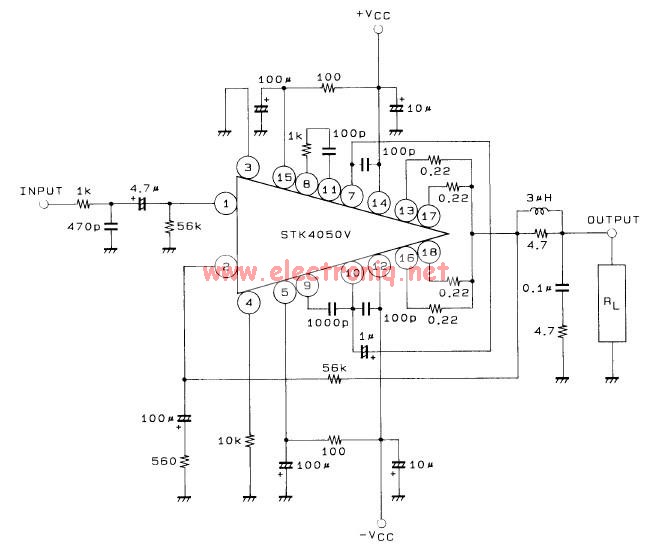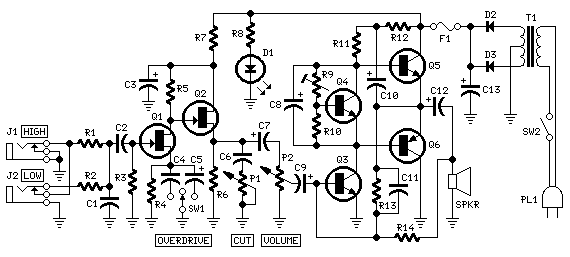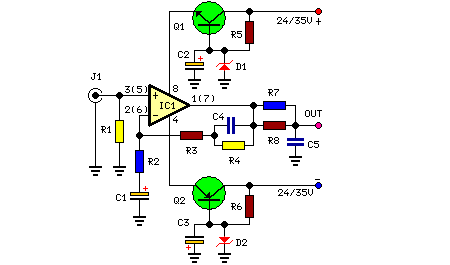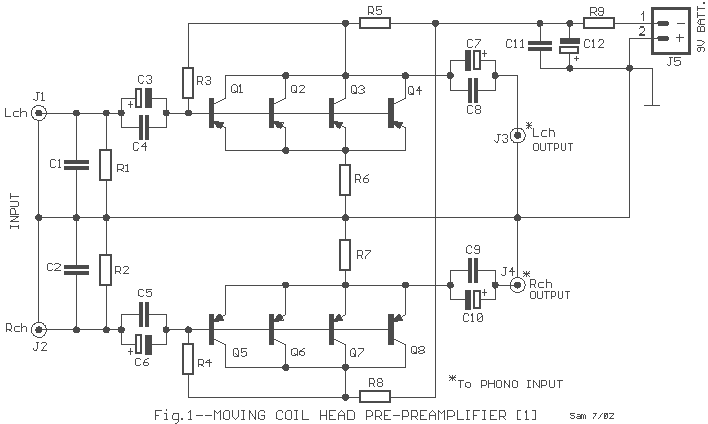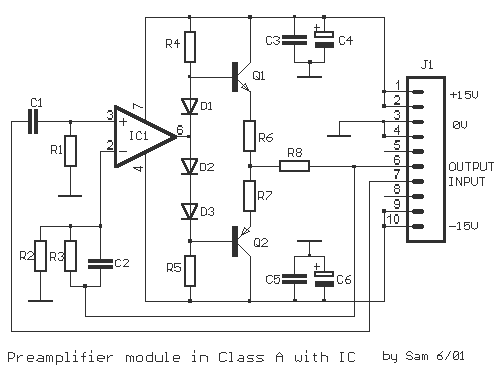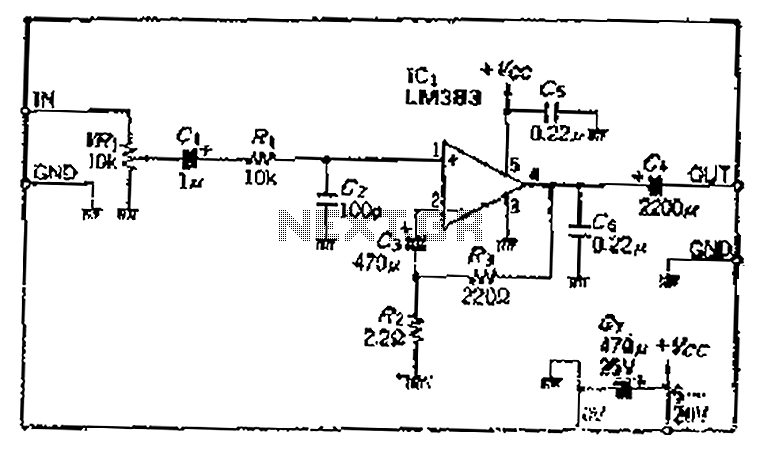
400 Hz SERVO AMPLIFIER
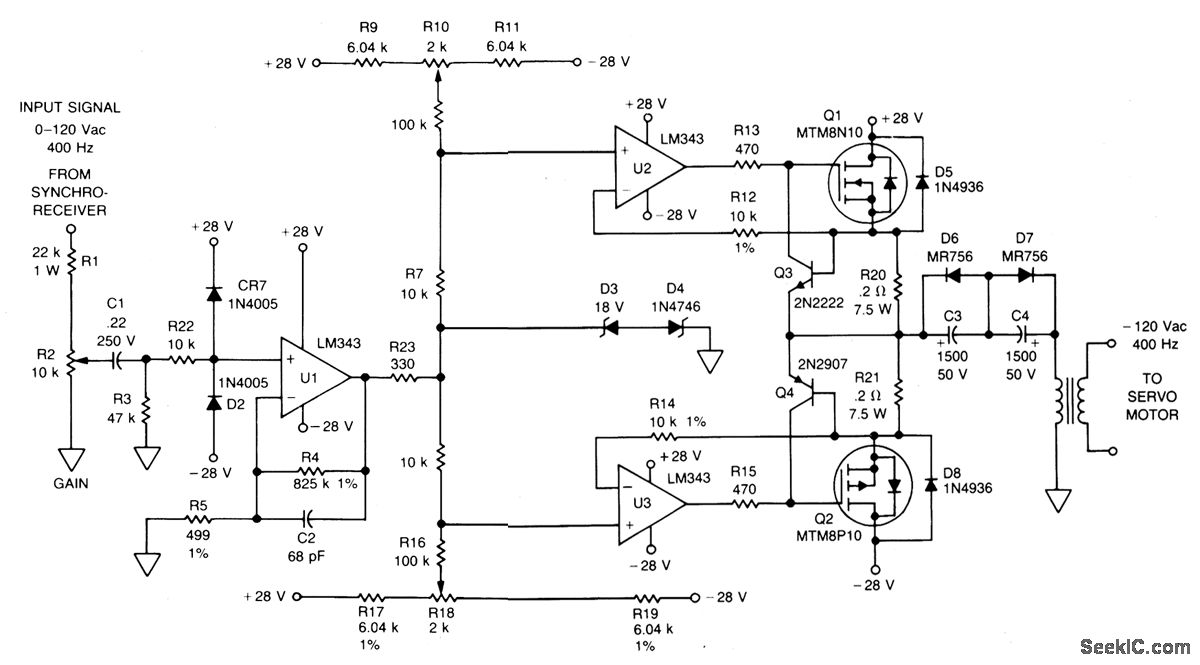
The signal from a synchro receiver or a variable resistive cam follower (potentiometer) is amplified by operational amplifier U1, with its output swing restricted by back-to-back zener diodes D3 and D4. This amplified signal is then fed into operational amplifiers U2 and U3, which control the gates of transistors Q1 and Q2, respectively. The npn transistor Q3 acts as a fast current limiter for the n-channel MTM8N10, while the pnp transistor Q4 serves the same purpose for the p-channel MTM8P10. Capacitors C3 and C4 are utilized to eliminate the necessity for precise DC offset zeroing. Transformer T1 elevates the output voltage to 120 V for the 400 Hz servo motor.
The circuit described involves several key components that work together to amplify and control an input signal for driving a servo motor. The initial signal, originating from either a synchro receiver or a potentiometer, is processed by operational amplifier U1. This amplifier is designed to boost the input signal while ensuring that the output does not exceed certain voltage levels, which is achieved through the inclusion of zener diodes D3 and D4. These diodes are connected in reverse parallel configuration, providing a protective clamping mechanism for the output, thus preventing potential damage to subsequent components from overvoltage conditions.
Following amplification, the processed signal is directed to operational amplifiers U2 and U3. These amplifiers are configured to further manipulate the signal before it is sent to the gates of transistors Q1 and Q2. The role of these transistors is critical, as they act as switches that control the flow of current to the load, which in this case is the servo motor.
Transistors Q3 and Q4 function as current limiters for their respective n-channel and p-channel MOSFETs (MTM8N10 and MTM8P10). This configuration ensures that the transistors operate within safe current limits, thereby enhancing the reliability and longevity of the circuit. The fast response time of Q3 and Q4 is essential for applications that require quick adjustments to the motor's operation, such as in servo control systems.
Capacitors C3 and C4 are strategically placed in the circuit to manage DC offset levels. By filtering out unwanted DC components, these capacitors help maintain the integrity of the AC signal driving the servo motor, thus simplifying the overall circuit design by negating the need for precise DC offset adjustments.
Finally, transformer T1 plays a pivotal role in stepping up the output voltage to 120 V, which is necessary for the operation of the 400 Hz servo motor. The transformer is designed to handle the specific frequency and voltage requirements of the motor, ensuring that it operates efficiently and effectively within the desired parameters. Overall, this circuit design illustrates a well-integrated approach to signal amplification and motor control, utilizing a combination of operational amplifiers, transistors, and passive components to achieve the desired functionality.The signal from a synchro receiver or a variable resistive cam follower (potentiometer) is boosted by operational amplifier U1, whose output swing is limited by back-to-back zeners D3 and D4. The signal is then applied to operational amplifiers U2 and U3, which drive the gates of Q1 and Q2 respectively.
The npn transistor (Q3) is a fast current li miter for the n-channel MTM8N10; a pnp transistor (Q4) performs the same function for the p-channel MTM8P10. Capacitors C3 and C4 eliminate the need for accurate dc offset zeroing. T1 steps up the output voltage to 120 V for the 400 Hz servo motor. 🔗 External reference
The circuit described involves several key components that work together to amplify and control an input signal for driving a servo motor. The initial signal, originating from either a synchro receiver or a potentiometer, is processed by operational amplifier U1. This amplifier is designed to boost the input signal while ensuring that the output does not exceed certain voltage levels, which is achieved through the inclusion of zener diodes D3 and D4. These diodes are connected in reverse parallel configuration, providing a protective clamping mechanism for the output, thus preventing potential damage to subsequent components from overvoltage conditions.
Following amplification, the processed signal is directed to operational amplifiers U2 and U3. These amplifiers are configured to further manipulate the signal before it is sent to the gates of transistors Q1 and Q2. The role of these transistors is critical, as they act as switches that control the flow of current to the load, which in this case is the servo motor.
Transistors Q3 and Q4 function as current limiters for their respective n-channel and p-channel MOSFETs (MTM8N10 and MTM8P10). This configuration ensures that the transistors operate within safe current limits, thereby enhancing the reliability and longevity of the circuit. The fast response time of Q3 and Q4 is essential for applications that require quick adjustments to the motor's operation, such as in servo control systems.
Capacitors C3 and C4 are strategically placed in the circuit to manage DC offset levels. By filtering out unwanted DC components, these capacitors help maintain the integrity of the AC signal driving the servo motor, thus simplifying the overall circuit design by negating the need for precise DC offset adjustments.
Finally, transformer T1 plays a pivotal role in stepping up the output voltage to 120 V, which is necessary for the operation of the 400 Hz servo motor. The transformer is designed to handle the specific frequency and voltage requirements of the motor, ensuring that it operates efficiently and effectively within the desired parameters. Overall, this circuit design illustrates a well-integrated approach to signal amplification and motor control, utilizing a combination of operational amplifiers, transistors, and passive components to achieve the desired functionality.The signal from a synchro receiver or a variable resistive cam follower (potentiometer) is boosted by operational amplifier U1, whose output swing is limited by back-to-back zeners D3 and D4. The signal is then applied to operational amplifiers U2 and U3, which drive the gates of Q1 and Q2 respectively.
The npn transistor (Q3) is a fast current li miter for the n-channel MTM8N10; a pnp transistor (Q4) performs the same function for the p-channel MTM8P10. Capacitors C3 and C4 eliminate the need for accurate dc offset zeroing. T1 steps up the output voltage to 120 V for the 400 Hz servo motor. 🔗 External reference
